

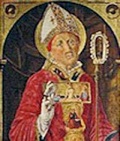
The Roman Martyrology records, under 3rd May:
-
“At Narni, St Juvenal, bishop and confessor”.
The cult of St Juvenal and his feast on on 3rd May must have been well established by the time of the Hieronymian Martyrology (430s or 440s), which had him martyred on this day , on Via Nomentana, seven miles from Rome, together with Alexander, Eventius and Theodolus (see below). It was certainly established by the 6th century: Gregory I, in his “Homiliarum in Evangelia” (2:37), records that St Cassius (bishop of Narni in 536-58 - see below) celebrated a daily Mass on the tomb of the holy martyr St Juvenal, which suggests that his presumed relics were already preserved in a martyrium of some kind. Other sources refer to St Juvenal as a martyr:
-
✴Gregory I, in the ‘Dialogues’ (Book IV, Chapter 12) had “the holy martyr, St Juvenal” appear to the dying Bishop Probus of Rieti.
-
✴The legend BHL 4615 that describes the theft of the relics of St Juvenal in 880 (see below) described this as his second martyrdom. (This legend is translated into Italian by Eduardo d’Angelo, referenced below, at pp.249-58).
The situation is further confused by the 9th century martyrologies:
-
✴the Martyrology of Florus recorded St Juvenal as the bishop and confessor of unspecified city who died on the 3rd of May (with a separate entry on that day for the martyrs from the Via Nomentana: Alexander, now erroneously identified as Pope Alexander I; Eventius; and Theodolus);
-
✴the Martyrology of Adon recorded St Juvenal as a martyr, but on 7th May; and
-
✴the Martyrology of Usuard recorded St Juvenal as:
-
•a bishop and confessor of unspecified city who died on the on the 3rd of May (again with a separate entry on that day for the martyrs from the Via Nomentana); and
-
•a martyr from an unspecified location, who died on 7th May.
A copy of the earliest known legend of St Juvenal (BHL 4614) is preserved under 3rd May in the Leggendari del Duomo. (It has been transcribed and translated into Italian by Eduardo d’Angelo (referenced below, at pp. 177--215). It records that St Juvenal was born in Africa and that Pope Damasus I (366-83) appointed him as the first bishop of Narni. Although Narni had been evangelised by St Terentian of Todi, St Felician of Foligno and St Valentine of Terni, it remained stubbornly pagan. St Juvenal erected a church dedicated to St Valentine, where he celebrated the mass and performed miracles. Such was his success that, on one occasion, he converted some 2,000 people on a single day. Five years after his consecration, he delivered the city from a barbarian attack, which presumably further enhanced his evangelical programme. He died on 7th August, seven years after his consecration and was buried outside the Porta Superiore of Narni. For reasons unspecified, his feast was celebrated on 3rd May, the feast of the discovery of the True Cross.
The barbarian attack mentioned above apparently took place some 400 years after a similar attack on the city that had occurred when Octavian (the future Emperor Augustus) had been in the east, before he had returned to rebuild the famous bridge over the Nera. This places the attack averted by St Juvenal in 369 (i.e. 400 years after the Battle of Actium of 31 BC). Thus, St Juvenal was consecrated in in 364 (actually, in the reign of Pope Liberius I) and died in 371.
BHL 4614 legend purports to have been written by St Juvenal’s successor, Bishop Maximus, who also built a basilica over St Juvenal’s grave. It also records that Maximus himself then held the bishopric for some 40 years (371-411). However, a number of references in it imply that the author knew of events that belonged to a later period. According to Edoardo d’ Angelo (referenced below, 2013, at p. 114):
-
“The hypothesis that seems most likely is that BHL 4614 represents the rewriting very early in the Carolingian period [i.e ca. 800] ... of an early medieval precedent ...” (my translation).
-
In relation to this putative earlier legend, it is interesting to note the, as discussed above, Gregory I had referred to a cult site for the holy martyr St Juvenal in the 6th century. This might well have been in the basilica recorded in BHL 4614, in which the later bishops Pancratius and Cassius were probably buried (in 493 and 558 respectively). It is possible that the earlier legend had been written at the time of the recognition of the relics of St Juvenal and their translation to the basilica, possibly during the episcopate of Bishop Maximus but certainly before 493.
Relics
As noted above, St Juvenal was buried outside the Roman city, close to Porta Superiore. This area seems to have been extensively used for early Christian burials: however, it is not possible to say whether St Juvenal was buried in an existing cemetery, or whether the existence of his grave stimulated the use of the surrounding area for burials.
As noted above, St Cassius (bishop of Narni in 536-58) celebrated the Eucharist each day on the tomb of St Juvenal. This suggests that there was a chapel over the tomb by this time. The existence of a funerary inscription relating to Bishop Pancratius (died 493) embedded in the wall of the present structure (see below) suggests that the original chapel was used for the graves of the bishops of Narni. Indeed, it is likely that St Cassius and his wife Fausta were also buried here (the former in 558).
The legend (BHL 4615) that describes the theft of the relics of St Juvenal and St Cassius and Fausta names the culprit as a Tuscan nobleman named Adalberto. He passed through Narni en route for Rome. He found the people there to be insubordinate, and was further incensed when his complaints before an unnamed pope were rebutted by a nobleman from Narni named Demetrius. Soon after this pope died, he extracted his revenge by laying siege to Narni and, when the city fell, stealing the relics of its protectors:
-
“Nec mora, sarcofaga rupta sunt, mausolea fracta, corpora sanctorum abstracta sunt, vehicula parata” (line 55).
(Without delay, the sarcophagi are broken, the mausolea fractured, the bodies of the saints are removed, ready for the carts). Thus, amid a great display of mourning, Adalberto’s men took the precious relics to Lucca, where they were housed in San Frediano. However, Lucca was visited with so many natural disasters that its citizens soon decided to return the relics of St Juvenal to the pope in Rome. They were duly venerated in St Peter’s for a few days before the pope himself accompanied them back to Narni.
The theft is usually placed at the door of Adalbert I, Margrave of Tuscany, who had participated in an attack on Rome in 878, an effort to force Pope John VIII to crown Carloman as Holy Roman Emperor. On this model, Adalbert I returned the relics of St Juvenal in order to secure the lifting of his subsequent excommunication. However, Edoardo d’Angelo (referenced below, at pp. 121-4) pointed out that the legend places the theft soon after the death of the unnamed pope who had refused to countenance Adalberto’s complaints. If this was, indeed, John VIII, the theft must have occurred after his death in December 882 and the restitution can have had nothing to do with his Adalberto’s excommunication.
-
✴Eduardo d’ Angelo, who believed that Adalbert I was certainly dead by 884, argued that there would have been only a short time for Adalberto to lay siege to Narni, steal the relics and then return them before his own demise. (Had the relics remained in Lucca until his death, the legend would surely have cited this as divine vengeance).
-
✴However, other scholars date Adalberto’s death to 886. In that case, he could have stolen the relics during the short reign of Pope Marinus I (882-4) and returned them at the insistence of Pope Adrian III (884-5) or Pope Stephen V (885-91). It has to be said, however, that it not clear that either of the last two popes could have enforced such a demand.
Edoardo d’ Angelo suggested that the thief was more probably Adalbert II (died 915), who was in Rome in 901 for the coronation by Pope Benedict IV of his ally, Louis of Provence, as Holy Roman Emperor (the short-lived Louis III ). On this model, the theft would have taken place shortly after the death of Benedict IV in July 903. D’ Angelo suggested that the restitution could well have been arranged under the auspices of:
-
✴Bishop John II Crescentius of Narni (940-60), who came from a powerful Roman family; or
-
✴his son, Bishop John III of Narni (960-2), whom the Emperor Otto I appointed as Pope John XIII (965-72).
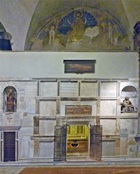
-
✴The relics of St Juvenal were rediscovered in 1642, placed in a new reliquary. In 1649, Bishop Gianpaolo Bocciarelli translated them to a new site in the crypt of San Giovenale.
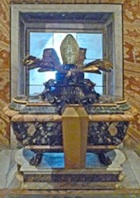
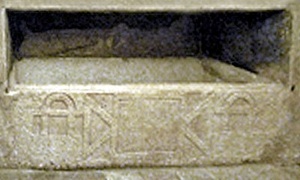
-
✴The sandstone sarcophagus (ca. 600 AD) that had contained the relics until that time remains in situ in the cavity in the rock behind the Sacello di San Cassio. It belongs to a group that seems to have been manufactured in Spoleto in the 5th century, two of which are known housed the relics of bishop saints: this one at Narni and the sarcophagus of St Felix, which is now in the Abbazia di San Felice di Giano. They are characterised by a low relief on one side that consists of a rectangle flanked by two triangles and then by two arches with architraves. A wide variety of dates has been proposed for this group of sarcophagi: that suggested here was suggested by Mario Sensi (referenced below, at p. 90):
-
“The sarcophagus at Foligno which was contemporary with those from Giano, Narni and Spoleto, is assignable on the basis of [the shared] decorative motif to the 6th or 7th century” (my translation).
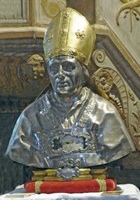
Cult of St Juvenal
As noted above, the cult of St Juvenal and his feast on on 3rd May must have been well established at terni by the time of the Hieronymian Martyrology (430s or 440s).
A number of records speak to the existence of the cult of St Juvenal in the region to the south of Narni from an early date:
-
✴The author of the life of Pope Vigilius (537-555) in the Liber Pontificalis reports that the Byzantine general Belisarius founded a monastery dedicated to St Juvenal at Orte.
-
✴The Abbazia di Farfa owned at least two churches dedicated to St Juvenal:
-
•at Rieti, donated in 792; and
-
•at Magliano, south of Orte, documented in 817.
There is also evidence that cult sites emerged along the route taken by the stolen relics in 878 and 880:
-
✴Massacio painted the San Giovenale Triptych (1422) for the rural church of San Giovenale in Cascia di Reggello, which was close to the Via Cassia some 100 km south of Lucca.
-
✴The church of San Giovenale at Orvieto, further south along Via Cassia towards Narni, had this dedication from at least 1004.
Read more:
E. d’Angelo, “Narni e i Suoi Santi”, (2013) Spoleto
M. Sensi, “Le Cattedrali di Foligno”, in :
G. Benazzi (Ed.), “Foligno A.d. 1201: La Facciata della Cattedrale di San Feliciano”, (1994) Foligno, pp 88-111
Return to Saints of Narni.
Return to the home page on Narni.

